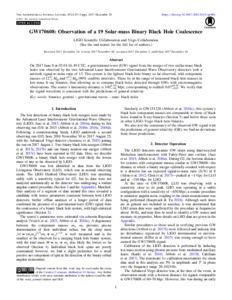Somala, S N and et al, .
(2017)
GW170608: Observation of a 19 Solar-mass Binary Black Hole Coalescence.
The Astrophysical Journal Letters, 851 (2).
pp. 1-11.
![[img]](http://raiithold.iith.ac.in/4010/1.hassmallThumbnailVersion/The%20Astrophysical%20Journal%20Letters_851_2_1-11_2017.pdf)  Preview |
|
Text
The Astrophysical Journal Letters_851_2_1-11_2017.pdf
- Published Version
Download (1MB)
| Preview
|
Abstract
On 2017 June 8 at 02:01:16.49 UTC, a gravitational-wave (GW) signal from the merger of two stellar-mass black holes was observed by the two Advanced Laser Interferometer Gravitational-Wave Observatory detectors with a network signal-to-noise ratio of 13. This system is the lightest black hole binary so far observed, with component masses of ${12}_{-2}^{+7}\,{M}_{\odot }$ and ${7}_{-2}^{+2}\,{M}_{\odot }$ (90% credible intervals). These lie in the range of measured black hole masses in low-mass X-ray binaries, thus allowing us to compare black holes detected through GWs with electromagnetic observations. The source's luminosity distance is ${340}_{-140}^{+140}\,\mathrm{Mpc}$, corresponding to redshift ${0.07}_{-0.03}^{+0.03}$. We verify that the signal waveform is consistent with the predictions of general relativity.
Actions (login required)
 |
View Item |


 Altmetric
Altmetric Altmetric
Altmetric